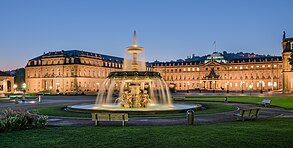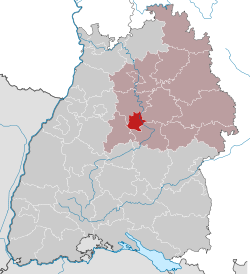
Back Stuttgart Afrikaans Stuttgart ALS ሽቱትጋርት Amharic Stuttgart AN شتوتغارت Arabic شتوتجارت ARZ Stuttgart AST Stuttgart Aymara Ştutqart Azerbaijani اشتوتقارت AZB
Stuttgart
Schduagert (Swabian) | |
|---|---|
| Coordinates: 48°46′39″N 09°10′48″E / 48.77750°N 9.18000°E | |
| Country | Germany |
| State | Baden-Württemberg |
| Admin. region | Stuttgart |
| District | Stadtkreis |
| Founded | 10th century |
| Subdivisions | 23 districts |
| Government | |
| • Lord mayor (2020–28) | Frank Nopper[1] (CDU) |
| Area | |
| 207.33 km2 (80.05 sq mi) | |
| Elevation | 245 m (804 ft) |
| Population (2022-12-31)[4] | |
| 632,865 | |
| • Density | 3,100/km2 (7,900/sq mi) |
| • Urban | 2,787,724 (31 Dec 2018)[3] |
| • Metro | 5,465,093 (2021)[2] |
| Demonym | Stuttgarter |
| Time zone | UTC+01:00 (CET) |
| • Summer (DST) | UTC+02:00 (CEST) |
| Postal codes | 70173–70619 |
| Dialling codes | 0711 |
| Vehicle registration | S |
| Website | stuttgart.de |
Stuttgart (German: [ˈʃtʊtɡaʁt] ⓘ; Swabian: Schduagert [ˈʒ̊d̥ua̯ɡ̊ɛʕd̥]; names in other languages) is the capital and largest city of the German state of Baden-Württemberg. It is located on the Neckar river in a fertile valley known as the Stuttgarter Kessel[5] (Stuttgart Cauldron) and lies an hour from the Swabian Jura and the Black Forest. Stuttgart has a population of 632,865 as of 2022, making it the sixth largest city in Germany,[6] while over 2.8 million people live in the city's administrative region[3] and nearly 5.5 million people in its metropolitan area,[2] making it the fourth largest metropolitan area in Germany. The city and metropolitan area are consistently ranked among the top 5 European metropolitan areas by GDP; Mercer listed Stuttgart as 21st on its 2015 list of cities by quality of living;[a] innovation agency 2thinknow ranked the city 24th globally out of 442 cities in its Innovation Cities Index;[b] and the Globalization and World Cities Research Network ranked the city as a Beta-status global city in their 2020 survey.[9] Stuttgart was one of the host cities for the official tournaments of the 1974 and 2006 FIFA World Cups.
Stuttgart is unusual in the scheme of German cities.[10] It is spread across a variety of hills (some of them covered in vineyards),[11] valleys (especially around the Neckar river and the Stuttgart basin) and parks. The city is known as the "cradle of the automobile".[12][13] As such, it is home to famous automobile museums like the Mercedes-Benz Museum and Porsche Museum, as well as numerous auto-enthusiast magazines, which contributes to Stuttgart's status as Germany's "Autohauptstadt" ("car capital city"/"capital of cars").[14][15][16] The city's tourism slogan is "Stuttgart offers more".[17] Under current plans to improve transport links to the international infrastructure (as part of the Stuttgart 21 project), Stuttgart unveiled a new city logo and slogan in March 2008, describing itself as "Das neue Herz Europas" ("The new Heart of Europe").[18] For business, it describes itself as "Where business meets the future". In July 2010, the city unveiled a new logo, designed to entice more business people to stay in the city and enjoy breaks in the area.[19]
Since the seventh millennium BC, the Stuttgart area has been an important agricultural area and has been host to a number of cultures seeking to utilize the rich soil of the Neckar valley. The Roman Empire conquered the area in AD 83 and built a massive castrum near Bad Cannstatt, making it the most important regional centre for several centuries. Stuttgart's roots were truly laid in the tenth century with its founding by Liudolf, Duke of Swabia, as a stud farm for his warhorses. Initially overshadowed by nearby Bad Cannstatt, the town grew steadily and was granted a charter in 1320. The fortunes of Stuttgart turned with those of the House of Württemberg, and they made it the capital of their county, duchy, and kingdom from the 15th century to 1918. Stuttgart prospered despite setbacks in the Thirty Years' War and devastating air raids by the Allies on the city and its automobile production during World War II. However, by 1952, the city had bounced back and became the major cultural, economic, industrial, financial, tourism and publishing centre it is today.[20]
Stuttgart is known for its strong high-tech industry, especially in the automotive sector. It has the highest general standard of prosperity of any German city. In addition to many medium-sized companies, several major corporations are headquartered in Stuttgart, including Porsche, Bosch, Exyte, and Mercedes-Benz Group. Stuttgart is an important financial center; the Stuttgart Stock Exchange is the second largest in Germany (after Frankfurt), and the Landesbank Baden-Württemberg (LBBW) is Germany's largest Landesbank. Stuttgart is also a major transport junction; it is among the most congested conurbations of Europe, and its airport is the sixth-busiest in Germany (2019). Stuttgart is a city with a high number of immigrants; according to Dorling Kindersley's Eyewitness Travel Guide to Germany, "In the city of Stuttgart, every third inhabitant is a foreigner."[21] 40% of Stuttgart's residents, and 64% of the population below the age of five, are of immigrant background.[22] In the rest of Germany, 28.7% of people are of immigrant background, with a relatively higher percentage living in cities and former western Germany (such as Stuttgart).[23]
- ^ Oberbürgermeisterwahl Stuttgart 2020, Staatsanzeiger.
- ^ a b "Stuttgart" (in German). Initiativkreis Europäische Metropolregionen. Archived from the original on 9 December 2019. Retrieved 7 August 2019.
- ^ a b "Bevölkerung nach Nationalität – vierteljährlich" (in German). statistik-bw.de. Archived from the original on 8 March 2021. Retrieved 7 August 2019.
- ^ "Bevölkerung nach Nationalität und Geschlecht am 31. Dezember 2022" [Population by nationality and sex as of December 31, 2022] (CSV) (in German). Statistisches Landesamt Baden-Württemberg. June 2023.
- ^ "Städte-Vergleich: Stuttgart fällt im Ranking zurück" (in German). stuttgarter-zeitung.de. Archived from the original on 10 March 2021. Retrieved 22 March 2022.
- ^ "The State and its people". State of Baden-Württemberg. Archived from the original on 27 June 2018. Retrieved 14 October 2018.
- ^ "Mercer's 2015 Quality of Living City Rankings". Mercer. Archived from the original on 1 May 2015. Retrieved 14 October 2018.
- ^ "Innovation Cities™ Index 2015 : Global". Innovation-Cities.com. 30 July 2009. Archived from the original on 27 June 2018. Retrieved 14 October 2018.
- ^ "The World According to GaWC 2020". GaWC – Research Network. Globalization and World Cities. Archived from the original on 24 August 2020. Retrieved 26 August 2020.
- ^ "Introduction to Stuttgart". The New York Times. 20 November 2006. Archived from the original on 13 September 2012. Retrieved 14 October 2018.[unreliable source?]
- ^ "Stuttgart, Germany". Lonely Planet. Archived from the original on 15 October 2018. Retrieved 14 October 2018.
- ^ "Things to Do in Germany". TripSavvy.com. Archived from the original on 15 October 2018. Retrieved 14 October 2018.
- ^ "Top Ten facts on Stuttgart, Slide 8". Global Blue. Archived from the original on 15 October 2018. Retrieved 14 October 2018.
- ^ Friedmann, Jan; Gorris, Lothar (11 August 2017). "Stuttgart: Eine Autostadt auf der Suche nach einer neuen mobilen Zukunft – DER SPIEGEL". Der Spiegel (in German). ISSN 2195-1349. Archived from the original on 17 April 2022. Retrieved 17 April 2022.
- ^ Fischer, Konrad (31 May 2017). "Feinstaub und Fahrverbote: In Stuttgart stirbt der Diesel". www.wiwo.de (in German). Archived from the original on 11 April 2021. Retrieved 17 April 2022.
- ^ Hägler, Max (15 June 2017). "Vorarbeit aus Stuttgart". Süddeutsche.de (in German). Archived from the original on 17 April 2022. Retrieved 17 April 2022.
- ^ "About Stuttgart". StudyInStuttgart.com. Study in Stuttgart. Archived from the original on 15 October 2018. Retrieved 14 October 2018.
- ^ "Statistisches Landesamt Baden-Württemberg". City of Stuttgart. Archived from the original on 16 April 2017. Retrieved 14 October 2018.
- ^ ""Will Jemand Eis?" Da Isses: Neues Logo für Stuttgart". Kessel.tv. 27 July 2009. Archived from the original on 15 October 2018. Retrieved 14 October 2018.
- ^ "Stuttgart". world-cities.eu. European Union. Archived from the original on 15 October 2018. Retrieved 14 October 2018.
- ^ Dorling 2001, p. 15.
- ^ "Neue Daten zur Migration in Deutschland verfügbar". Destatis.de. 20 October 2008. Archived from the original on 18 July 2011. Retrieved 14 October 2018.
- ^ Bildung, Bundeszentrale für politische (29 April 2023). "Bevölkerung mit Migrationshintergrund". bpb.de (in German). Retrieved 9 January 2024.
Cite error: There are <ref group=lower-alpha> tags or {{efn}} templates on this page, but the references will not show without a {{reflist|group=lower-alpha}} template or {{notelist}} template (see the help page).











